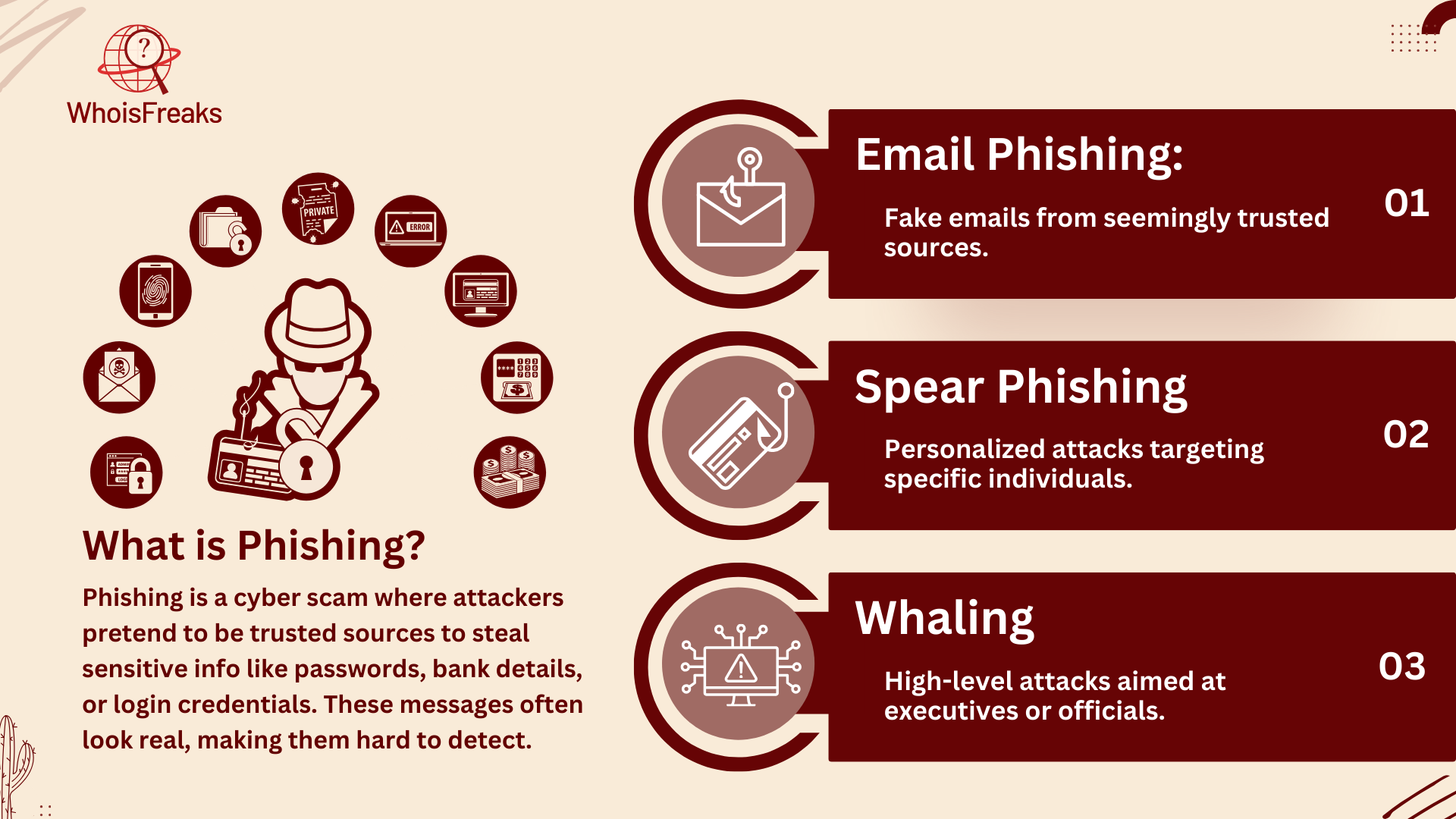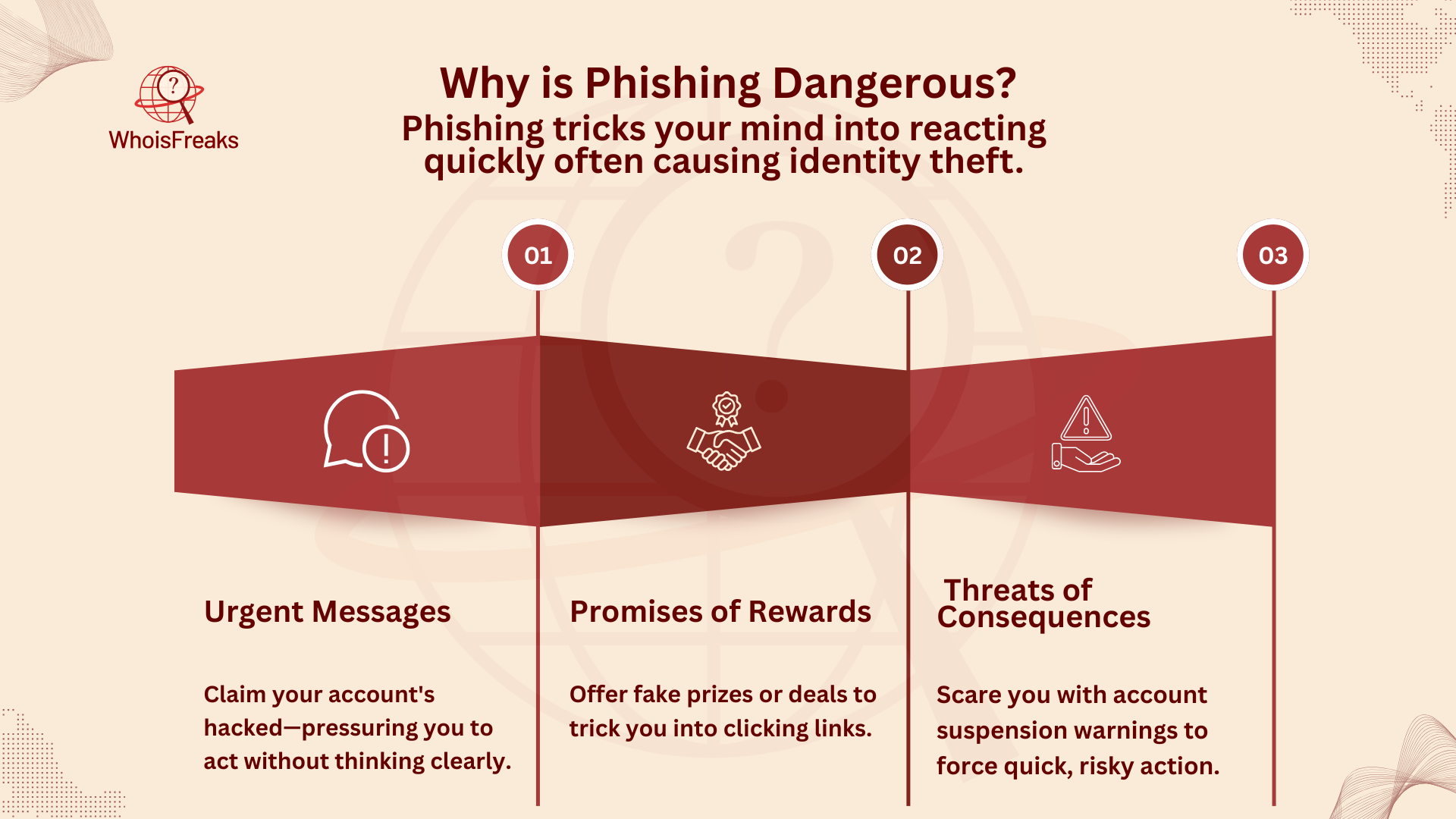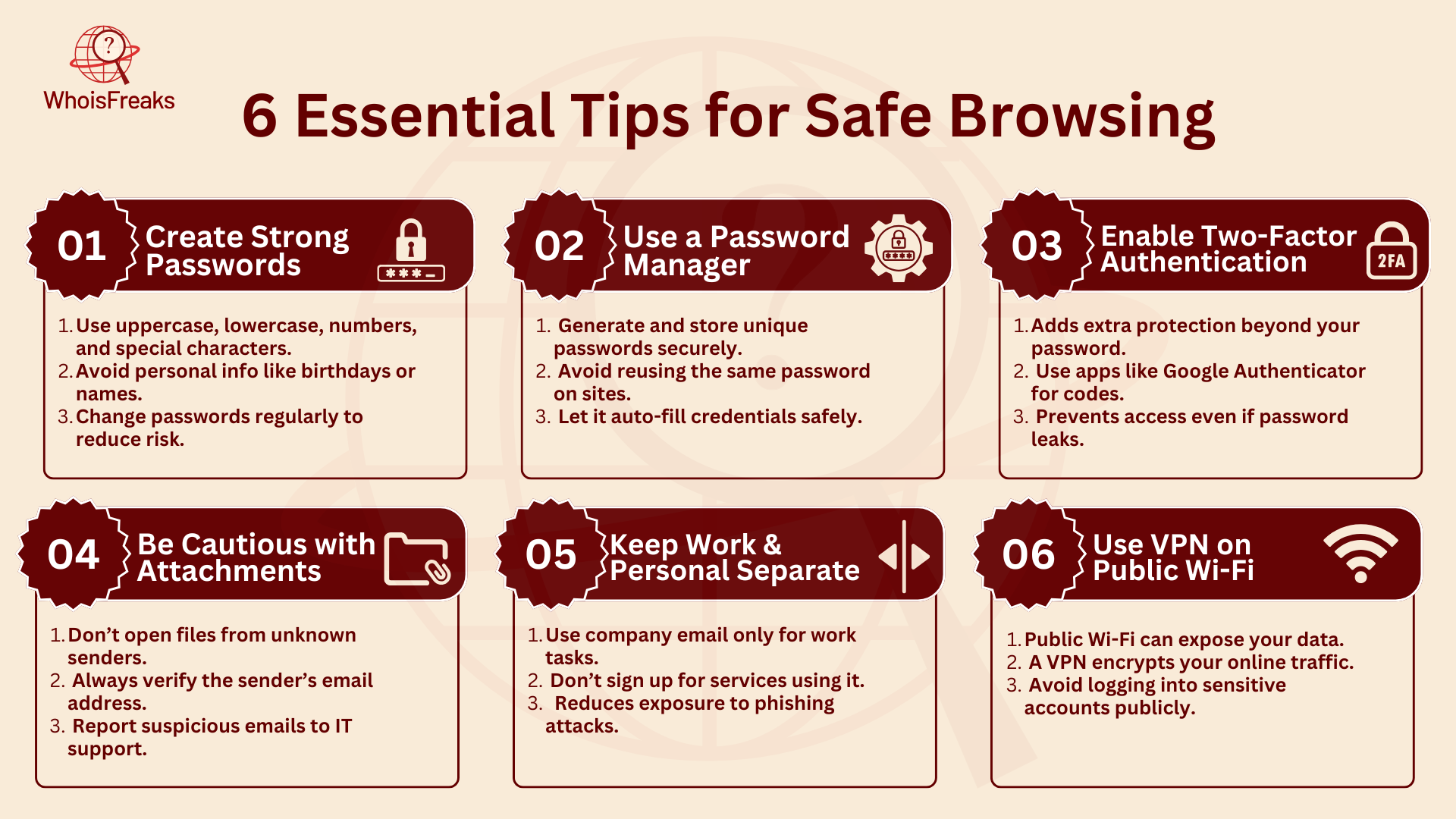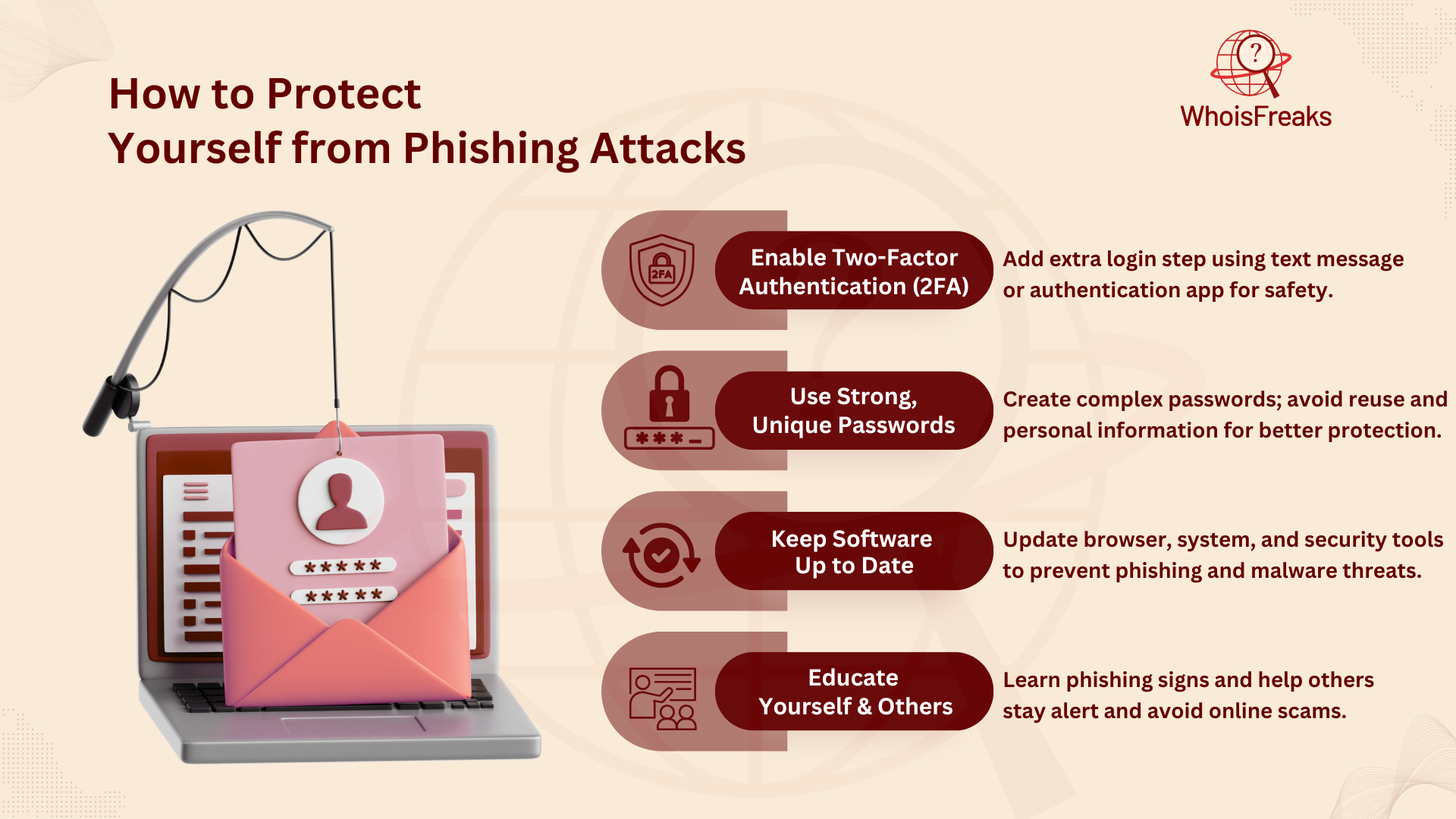
How to Spot a Phishing Email: Essential Tips for Online Safety
How to Spot a Phishing Email: 6 Essential Tips for Safe Browsing
Phishing emails have become one of the most frequent online dangers. They are crafted to deceive you into sharing personal information, such as passwords, bank details, or other sensitive data. These emails can seem legitimate and trustworthy, making it tricky to figure out whether they’re genuine or not. But don’t worry with some basic knowledge and awareness, you can easily spot them. In this blog, we’ll share six simple tips to help you recognize phishing emails and browse the internet more safely.
What is phishing?
Phishing is a type of online scam where attackers pretend to be trusted people or organizations to trick you into clicking dangerous links or downloading harmful attachments. Their main goal is to steal your personal info, like login credentials, passwords, bank details, or other sensitive stuff. Phishing emails are made to look real, so they can be tricky to spot without knowing what to look for.

Phishing can show up in different ways:
- Email Phishing: The most common type, where scammers send fake emails that seem like they’re from people you trust.
- Spear Phishing: A more targeted scam, where the attacker makes the email look like it’s from someone you know personally.
- Whaling: A special kind of spear phishing aimed at important people, like company leaders or government officials.
What is a phishing email?
Phishing attacks, especially phishing emails, are becoming more common these days. With billions of emails being sent and received every day, it’s getting harder to tell which ones are real and which ones might be trying to trick you. Phishing emails are getting smarter, making it tough for people to figure out which emails are safe, and which ones could steal your personal information. This makes it even more important to stay alert and know how to spot these suspicious emails and fake emails in your inbox.
Why is Phishing Dangerous?
Phishing is dangerous because it takes advantage of how we think and react, often leading to identity theft. These emails often make you feel like you need to act fast or get curious, pushing you to make quick decisions without fully thinking through the risks. Some phishing emails might include:

- Urgent messages: Saying your account has been hacked and you need to act immediately.
- Promises of rewards: Offering tempting things like prize money or special deals.
- Threats of negative consequences: Warning that your account will be suspended or that something bad will happen unless you act right away.
These tricks work well because they trigger emotional reactions, making you more likely to make hasty decisions that could expose your personal information.
The Growing Threat of Phishing Emails
Phishing attacks are getting smarter as hackers use better tricks to fool people. One way they do this is by spoofing email addresses, making them look like they come from trusted sources. This makes it harder to spot fake emails and recognize suspicious activity. Hackers also use social engineering, which means they craft emails that mention personal details, like recent purchases or public information, to make the message seem real. Some even pretend to be important people, like government agencies or law enforcement, to scare people into responding. Social media has made it even easier for attackers to get information, helping them make their emails more convincing. Because of all these tricks, it’s becoming harder to tell the difference between real and fake emails, so we need to stay extra careful.
How to spot a phishing email?

Phishing emails usually have at least one of these warning signs:
- Asks for Sensitive Information: They may ask for personal details like passwords, bank information, or social security numbers.
- Uses a Different Domain: The email may come from a strange or unusual email address that looks similar to a trusted one but isn’t quite right.
- Contains Links that Don’t Match the Domain: The links in the email might not lead to the official website; they often redirect to fake sites.
- Includes Unsolicited Attachments: If there’s an unexpected attachment, it could be a virus or malware.
- Is Not Personalized: The email might not address you by name or seem very generic.
- Uses Poor Spelling and Grammar: Many phishing emails have errors, including misspellings or awkward language.
- Tries to Panic the Recipient: They may create a sense of urgency, making you feel like you need to act immediately.
6 Essential Tips for Safe Browsing

1. Create Strong Passwords
When it comes to email security, a strong password is essential for keeping your account safe. A weak password won't protect your email or sensitive company data. Make sure your password includes a mix of upper-case and lower-case letters, numbers, and special characters. Avoid using common words from a dictionary or personal details, such as payment information, phone numbers, birth dates, anniversaries, pets’ names, or home addresses, as they can be easily guessed. Also, avoid using simple letter/number swaps, like replacing "o" with "0." Instead, use longer phrases that are harder to guess. Make sure to update your password regularly to reduce the chances of a security breach.
2. Use a Password Manager
A password manager can make it easier to create and store strong, unique passwords for each account. This tool helps you avoid the temptation to use weak passwords or reuse the same password across different sites, which makes your accounts more vulnerable to attacks. By using a password manager, you can store all your passwords securely and let the tool generate complex passwords for you. This ensures that your sensitive company data remains protected without having to remember every password yourself.
3. Turn On Two-Factor Authentication
Two-factor authentication (2FA) adds an important extra layer of security to your email account. With 2FA, after you enter your password, you'll be asked to provide a second form of identification, usually a one-time code sent to your phone or an app like Google Authenticator. This makes it much harder for cybercriminals to access your account, even if they manage to guess or steal your password. If a hacker tries to break into your account, they will need your phone or access to the authentication app to bypass it, making it crucial to report phishing attempts.
4. Be Careful with Unexpected Attachments
Whenever you receive an email with an attachment that you weren't expecting, pause and double-check the sender's email address. Hackers often send phishing emails that appear to be from someone you know but are actually trying to trick you into opening malicious files. If the email looks suspicious or comes from an unfamiliar source, don’t open any suspicious attachments. Your email program may have virus scanning tools that help block spam and known harmful files, but it’s always wise to have your IT department ensure that your email settings are optimized for the best protection.
5. Don’t Use Company Email for Personal Stuff
To avoid putting your company’s email security at risk, keep your company email strictly for work-related matters. Using your work email for personal reasons, such as online shopping, signing up for subscriptions, or communicating with friends, can expose your email account to unnecessary risks. By limiting the use of your company email to business purposes only, you help reduce the chances of cybercriminals gaining access to your sensitive information. Make sure everyone in your organization, from the newest hire to the CEO, follows this policy to ensure the safety of the entire company's email system.
6. Protect Yourself on Public Wi-Fi
Public Wi-Fi networks, like those found in airports, coffee shops, or other public spaces, are often not encrypted, making it easy for cybercriminals to intercept your data. When you connect to these networks, hackers can access the information you send and receive, including your sensitive emails and personal data. To stay safe, always use a Virtual Private Network (VPN) when connected to public Wi-Fi. A VPN encrypts your internet connection, making it much harder for attackers, who may have access to your social media posts, to see your data. Using a VPN ensures that your company’s sensitive information remains private, even when you’re working in a public space.
How to Protect Yourself from Phishing Attacks
To protect yourself from phishing attacks, here are some simple steps you can take:

- Enable Two-Factor Authentication (2FA): This adds an extra layer of protection to your accounts by requiring a second method to verify your identity, like a text message or an authentication app.
- Use Strong Passwords: Make sure your passwords are long, unique, and complex. Avoid using the same password for multiple accounts.
- Keep Software Up to Date: Always update your browser, operating system, and security software. This helps guard against malware and other online threats.
- Educate Yourself and Others: Stay informed about the latest phishing tactics and share your knowledge with friends and family to help protect them too.
Real-World Example: The 2016 U.S. Democratic National Committee (DNC) Phishing Attack
Phishing attacks can have serious and far-reaching effects, as shown by the 2016 hack of the U.S. Democratic National Committee (DNC). In this high-profile case, Russian intelligence operatives used spear phishing to break into the DNC’s internal email system, leading to the leak of sensitive emails that had a major impact on the U.S. presidential election.
The attackers sent a carefully designed phishing email that tricked DNC staff into clicking on a harmful link. The email looked like a legitimate message from Google, telling users their accounts were compromised and urging them to change their passwords. When staff clicked the link, they were sent to a fake Google login page where they unknowingly entered their login details. This gave the hackers access to the DNC’s network, where they spent months stealing sensitive data.
The breach was revealed when the hackers began leaking the stolen emails to the public, causing major political and reputational damage. This incident highlighted how effective phishing can be in political contexts and showed the urgent need for stronger cybersecurity measures, like multi-factor authentication, better email filters, and more user education, to prevent such breaches.
Conclusion
Phishing attacks remain one of the most widespread and harmful forms of cybercrime. As technology keeps evolving, cybercriminals are finding new ways to trick people, making it harder to tell the difference between real and fake emails. However, by staying alert, carefully verifying unsolicited messages, and learning how to identify phishing emails, you can greatly lower the risk of falling victim to phishing.
At the end of the day, awareness and education are your best defense. Phishing emails are designed to take advantage of human mistakes, and while the techniques used can be high-tech, many attacks still rely on simple tricks like playing on emotions such as urgency and fear. Recognizing the signs of phishing and knowing what to do can make all the difference in keeping your personal and financial information safe.
FAQs
1. What is the strongest indicator of a phishing email?
The strongest indicator of a phishing email or phishing messages is a suspicious sender email address or an unexpected request for personal or sensitive information.
2. How will you identify a phishing email?
You can identify a phishing email by checking for strange email addresses, urgent language, spelling mistakes, or unexpected attachments.
3. What does a good phishing email look like?
A good phishing email looks very real, often mimicking trusted sources, with logos, official-looking text, and urgent requests to take action.
4. How can phishing emails be spotted?
Phishing emails can be spotted by looking for signs like unusual sender addresses, grammatical errors poor grammar, suspicious links, or requests for sensitive information.

Software Engineer
A software engineer focused on developing scalable, efficient solutions. Expertise in coding, system optimization, and utilizing advanced technologies for high-performance apps.
Related Posts

Understanding Domain Fronting: Benefits, Risks, an...
Explore the benefits and risks of domain fronting, its applications, and how it impacts online privacy. Read the article for a comprehensive overview.
Published at: Nov 20, 2025

Essential Strategies to Prevent Subdomain Takeover...
Learn how to prevent subdomain takeover with essential strategies and best practices. Protect your online assets—read the full guide now!
Published at: Nov 18, 2025

Understanding Spear Phishing: Key Insights and Pre...
Learn about spear phishing: its types, risks, and effective prevention strategies to safeguard your digital life. Read more to protect yourself today.
Published at: Nov 10, 2025

Understanding Cache Poisoning: Risks and Preventio...
Learn about cache poisoning risks and effective prevention strategies to safeguard your online presence. Read the article to protect your systems toda...
Published at: Nov 5, 2025